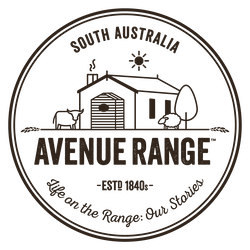The Old Families
Life on the Range – Chapter 3
Naming of Bull Island
Pat Conrick
Bull Island (or as it was once known – Bull’s Island) was named by Commander Bull in honour of himself. Commander Bull was in charge of a Royal Naval Sailing Ship sent to Lacepede Bay to search for survivors of the brig Maria, which ran aground in a storm near the mouth of a small creek, which was later named Maria Creek after the wrecked ship. The Maria was anchored off the coast for a couple of days, in a great storm, but eventually her anchor gave way and the Maria Creek was washed on to the shore and wrecked.
Many of the Bunganditj (Boandik) people visited the area to see the ship, hiding fearfully in the dunes as they watched. Members of the local tribe, the Mootatunga people, also witnessed the ship being wrecked. As soon as the crew came ashore they caught one of the men of the Mootatunga tribe and hung him as an example to the other Aborigines. There were many women and children who reached the shore from the ship, and they, with the surviving men and crew members, set out north west in an attempt to reach Adelaide. They were guided as far as what is now Salt Creek by a Mootatunga warrior by the name of Kiddieburner. He refused to go past Yakile (Salt Creek) because it would be to travel outside his tribal lands and the Coorong Aboriginal tribe (Tanganekaid) were very fierce and warlike.
As the Maria broke up much of her cargo was washed ashore, and some was salvaged from the vessel, including bags of flour and other food. As the Aborigines were hungry they had a great Murapena (Coroboree) and feasted on the flour, eating it dry. Many of the children, especially the very young, died from eating so much dry flour. The Aborigines became very frightened by this and left the area without even burying their dead, but a few came back from time to time to have another look at the figurehead of the “Maria” as they found it very fascinating and a great curiosity.
Commander Bull landed at the mouth of the Maria Creek and led a party from his crew inland from the coast. Despite a very wet winter, the party managed to travel about 25 kilometres inland. From a vantage point on what is now the West Avenue Range, Commander Bull could see a small island in a sea of water, on what is now known as the Avenue Plains. He named this island “Bull Island” in honour of himself. As an afterthought he also wrote in his log – “This country appears to be well watered!”
Bull Island
William H. Limbert arrived in Australia in the “Psyche” on January 17th 1849 and had a chemist shop in Mt. Pleasant for several years. His brother Henry (1836-1921) joined him in 1858. Henry returned to England and married Jane Harvey on April 15th, 1863. The family returned to South Australia and opened a store and chemist shop at Kingston. In April, 1880 Henry purchased Sections 103, 1’05 and 107 Hundred of Townsend at auction in Adelaide and moved to Bull(s) Island in September of that year, by which time they had five children -Mary (1864), Frank (1865), Jessie (1866), Edward (1868-1958) and the baby Lillian ( 1878). In those days the flats were covered with honeysuckle (later cleared for timber to fuel the trains) and Lillian was dressed in red in case she became lost. In 1888 Henry Limbert purchased 3,265 acres in the Hundred of Minniecrow and his daughter Mary 4,232 acres in the Hundred of Townsend. The only one of Henry’s children to marry was Edward Harvey Limbert who, in 1900, married Sarah Jane Styles of Kingston, whose father was the Harbourmaster there. On Wednesday, 19th February, 1908 J.A. Hensley offered the whole of the Cairnbank estate and outside properties. Edward Limbert purchased Sections 114, 115 and 122 Hundred of Townsend.
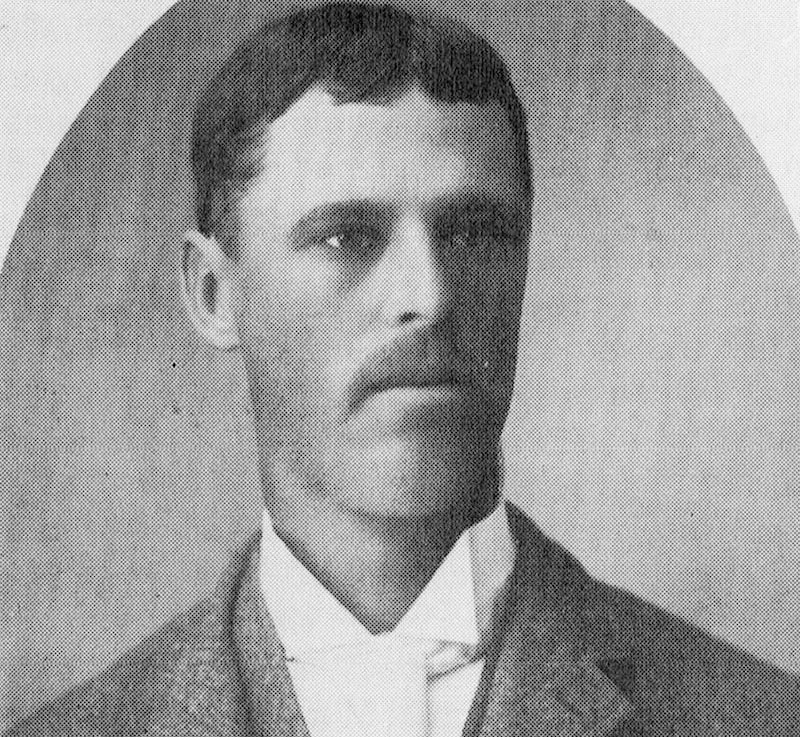
Edward Harvey Limbert
Edward and Sarah had four sons -Harvey (1902), Lloyd ( 1905), Gavin (1906) and Melville Louis (1908).
After the Second World War part of Bull Island was relinquished for Soldier Settlement. Harvey and Gavin Limbert farmed together at Bull Island until Gavin’s death in 1943, when Harvey purchased Gavin’s land. Lloyd had a property at Lucindale and Melville a property at Naracoorte.
In 1933 Harvey married Norah Chaplin and they had one daughter Jennepher (1935) who married Brian Gilkes in 1957. They still run the family property and have three. children -Henry ( 1959), Sarah ( 1961) and Charles (1964).
Jennepher Gilkes (nee Limbert)
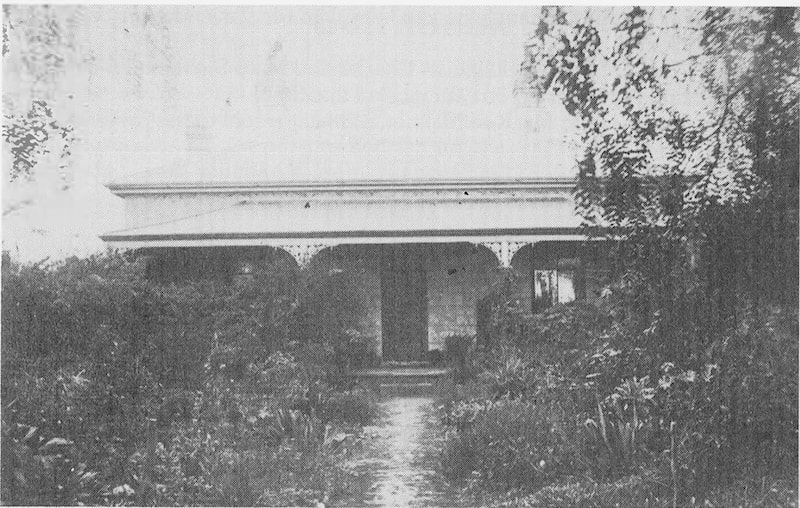
Ted Tavender -“Walteela”
Towards the end of 1880 or early in 1881, Samuel Tavender and his wife Caroline bought and settled at Bull Island on what was later known as Tavender’s “Flat” paddock, after having travelled overland from Angaston by bullock wagon with the bulk of their possessions being brought by sailing ship from Pt. Adelaide to Kingston.
After five years, in about 1886, Mr. Tavender took up more land, some of which was part of the old “Avenue Plains” station, naming the whole property “Walteela” which, according to what has been handed down by word of mouth, is an Aboriginal name meaning ‘meeting place’ or neutral land where tribes met in peace.
A shearing shed was among the first buildings erected, one of their children being born in it. The house was built in 1888-89 with extra rooms added as demanded by family size. The lime stone and lime for mortar were produced on the property, Mr. Tavender’s father David being a stone mason by trade.
Samuel Tavender ran the property from its beginning in about 1886-87 till around 1919, his main interest being sheep grazing. During those years he served on the Lucindale Council for eighteen years, travelling by horse and buggy from “Walteela” to Lucindale to attend council meetings. He was also instrumental in the formation of the South East Drainage scheme, as “Walteela” in common with most properties in the area, had a proportion of flat land which was covered with water in winter time.
Samuel Tavender “retired” to Naracoorte and ceased to be actively interested in “Walteela” in 1919 when the property passed to his eldest son, Samuel Edgar (Ted) Tavender, who continued as a sheep grazier until his death in 1943, when, under the terms of his will, “Walteela” passed to his nephews Sam and Peter Altman, the Altman family having lived with Mr. Tavender on “Walteela” from 1930 till 1941.
From 1943 to 1958 the well known Charles and Mary Smith and their family rented the property and lived on it for most of that time.
In 1958 it was sold to Mr. Ken Mattner and later resold to the present owner Mr. Brian Copping.
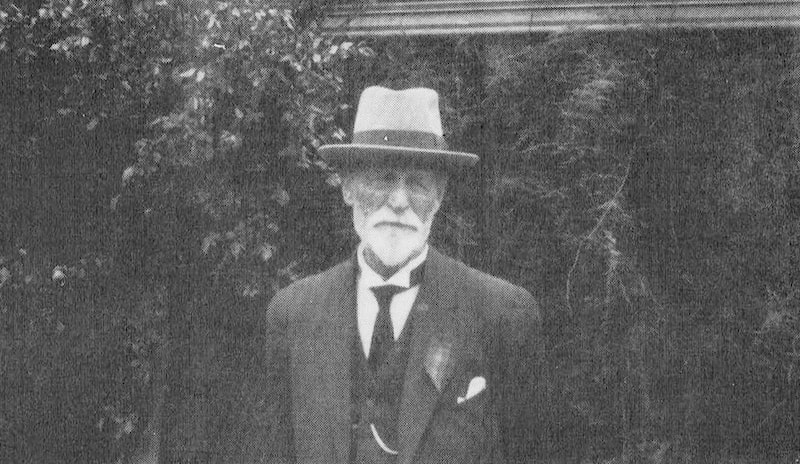
Sam Tavender in front of the “Walteela” homestead.
Brian and Alison Copping – “Walteela”
Eventually I purchased Walteela in 1964 from the late Ken Mattner, who had purchased it earlier from the estate of S.E. Tavender. I purchased 1081 acres of which approximately 250 acres were developed in some form while the fences were almost non-existent. It was running 600 or so wethers, but development has increased it to 3 D.S.E.
My parents had two children – Keith born in 1926 and myself born in 1931. Keith did primary school at Avenue plus two years at P.A.C. I attended Avenue Naracoorte High for three years and one year at P.A.C.
My o?n family all attended Lucindale Area School with Janet having two years at M.L.C. Janet worked all over Australia and New Zealand before coming to join me at home. Kathryn did psychiatric nursing before managing a store at an Aboriginal settlement near Darwin for two years. She is now doing whatever work is offering around this district. Elizabeth studied Horticulture at the Adelaide Botanic Gardens and married Michael Young and is living in Merbein, Victoria. Gillian has tried her hand at just about everything as well as doing a two-year photography course. Currently, she is in England for 1 to 2 years. David spends half the year at home and the other half on nearby properties working for others.
Brian Copping
Cairnbank
Alexander Stewart and his wife arrived from England in 1839 and, after working as a surveyor in the South East for several years, he occupied 79 square miles named “Cairnbank”. However, due to the depredations of wild dogs and scab, Alexander did not prosper and left for the Ballarat goldfields in 1852. “Cairnbank” was purchased from Stewart, in 1852 by John Hensley of Meadows in the Adelaide Hills. He moved with his family along the Coorong using a bullock dray and spring cart and droving a mob of cattle.
John Alexander Hensley had arrived from England in the ship “Pestongee Bomangee” in 1838. He remained in South Australia for twenty seven years before retiring to Geelong. John Hensley Jnr. took over the running of the property and was noted for his prowess with horse teams. It is reported that around 60,000 sheep were shorn in the Cairnbank woolshed at its peak. Hensley was instrumental in finding a treatment for scab in sheep. However, he met with leaner times and the whole of “Cairnbank” and all its outside properties including Leasehold land in the Hundreds of Woolumbool, Marcollat and Peacock, as well as Gip Gip, Didicoolum and Bunbury – totalling 188, 456 acres were offered for sale on 19th February 1908. Edward Limbert purchased three sections at this time. However, it is recorded that Hensley did not leave “Cairnbank” until 1915 when he retired to Bordertown.
As far as Brian Copping knows his father purchased “Cairnbank” from the Bank in 1917 after John Hensley had been forced to walk out. Alfred David Copping had come from the well-known family of “Redbank”, Lucindale, where they had moved in 1870.
When Alfred took up “Cairnbank” there were no pasture improvements, the fences were in a shocking state and the place was over-run with rabbits. Due to the economic situation at the time, it was impossible to do much to the fences until 1938-39. Then war came and put a stop to fencing, so that by the time materials became available after the war, most of the fences were barely stockproof. One of the problems in the early days at “Cairn bank” was coastiness in the sheep. The paddocks to the west of “Cairnbank” were not too bad, but east of “Cairnbank” had problems. In the 1930’s the Department of Agriculture experimented with trace elements in the pastures thus overcoming coastiness and various other forms of unthriftiness.
Isolation was something of a problem until the telephone was connected in 1925. W.A. Paltridge and Sons were connected in 1929 on a party line, so Mrs. Lou Paltridge and Mrs. Copping reduced the isolation by talking together. Alfred Copping married Ina Hemmings, a former teacher at the Avenue Range school, in 1924 and they bought their first car in 1926. The roads, even in Brian’s recollection, were not good. He can remember being bogged in the sand in the scrub near Neil Watts’ home.
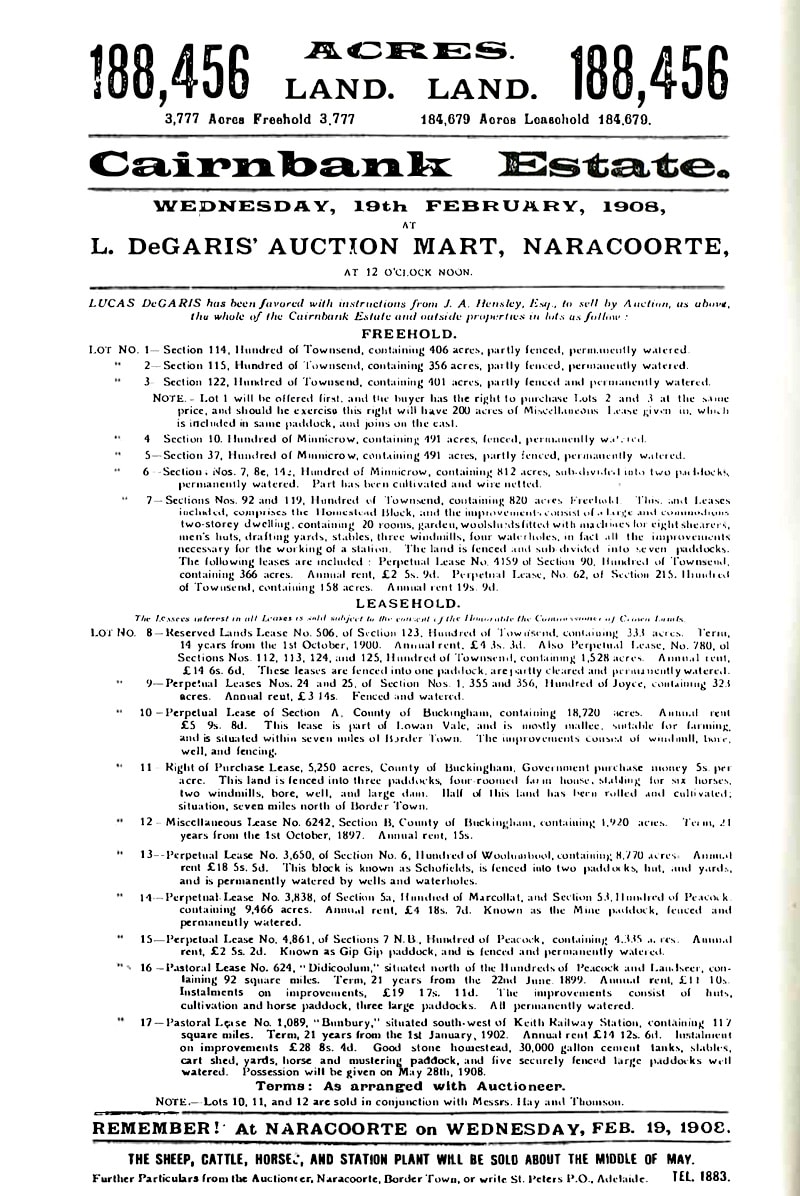

Cairnbank homestead built in 1868 by Smith and Agar in conjunction with W. T. Gore, architect.
Ted and Shirley Rivett – “Downer”
Thomas Rivett was born in ?820 and emigrated from England on the ship Oregon which left Plymouth in July 1851 arriving in Adelaide in October of the same year. He married Louise Self in 1853 and their family included Zephaniah, Louise, Mary and David. Thomas died on June 27th 1878 and was buried in the Kingston cemetery.
Zephaniah married Mary Ann Serie on the 20th May 1885. They had a family of eleven: Will, May, Pere, George, Sophia, Ethel, Myrt, John ‘ Os ‘ Bob and Gordon.
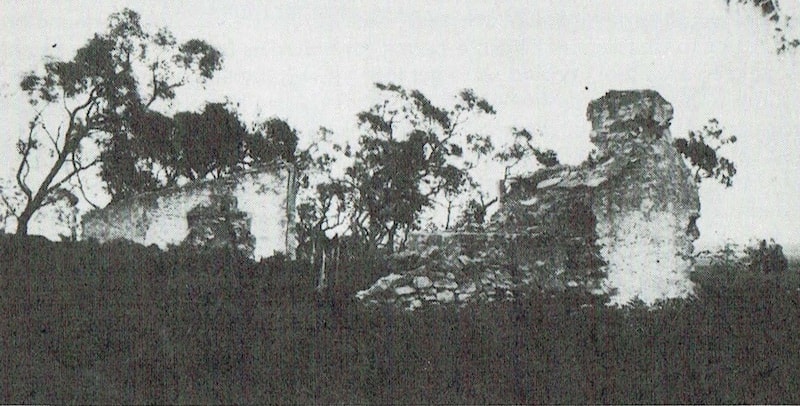
“Lawser’s” the home of Zephaniah and Mary Ann Rivett over 100 years ago.
The Rivett family settled at Avenue Range over one hundred years ago, when Zephaniah and Mary Ann Rivett’s first home was on the side of a hill at “Lawsers”, a property south of the railway line and which now belongs to Mr. Bub Mason. Their first child was born there in 1886 and some time later they moved to “Downer” where they raised a family of thirteen children. Ten thousand acres was eventually taken over by their son George Serie Rivett, who with his English bride Rose, reared four children -Gertrude, Thelma, William (Bill) and Edward (Ted), but tragically Rose died shortly after Ted was born.
The children were all educated at the Avenue Range School and attended church and Sunday School in the same building.
In 1941 Ted joined the Army and served in the 27th South Australian Scottish Regiment in New Guinea and Bougainville and was discharged in 1:45,when he returned to Avenue Range and resumed farming in partnership _ with his
father George and brother Bill. This partnership continued with Bill and Ted after the death of their father in 1957 until 1972 when the land was divided between the two brothers. The creek country on the western side of Avenue consisted of 7,000 acres, but in the early 1960’s the District Council put a road_ through to the Soldier Settlers’ blocks at West Avenue, thus dividing the property. Three thousand acres were sold to Haage and Gursansky.
My first introduction to Avenue Range and country life was in 1946, after Ted had been discharged from the Army. Our friendship began during the war when my brother Clem who was in the same unit, brought Ted to our home when ?n leave. We corresponded whilst he was serving overseas and our friendship continued when he came back to Australia awaiting discharge. I travelled from Adelaide with Ted’s sister Gertrude, on that interminable journey by narrow gauge train, arriving at Avenue an hour or so late. (Years later, when my own children, journeying to Adelaide by car, and being asked every few miles, “How much further?” made me think I must have driven Gert mad with the same question).
Our courtship continued but we were only able to see each other three times a year, Christmas, Anzac and Adelaide Show week.
We were married in May 1949 and started our married life in a small tworoomed asbestos cottage with enclosed back verandah. It took us nearly two years prior to that date to obtain a permit for materials to build and it was only the isolated area that enabled us to get that. It was the first house to be built in Avenue Range in twenty-five years, the previous one being Mr. Will Thomas’s house, next door. Our bath was a galvanised one Ted had bought from a clearing sale for 2 pounds, likewise the washtroughs which stood at the back of the house with a brand new copper. There I did my washing until the summer of that year, when my washhouse was built of scrub timber and asbestos, and what a luxury to have water connected over the troughs!
The Tilley and kerosene lamps and Mrs. Potts irons were quite different from what I had been used to in Adelaide, but I loved being with my husband in our little home and I adapted to country life quite well. By Christmas we had our own small car, a Morris 8/40, so decided to build a garage. Permits were still needed for building materials -and money -so we resorted to scrub posts, sewed super bags together for the sides and used asbestos over from the house for the roof, and so we had a very neat cover for the car.
In February next year our first child was born, a daughter Christine Kaye.
We enjoyed tennis with the locals at that time, the court being a “dirt’ one on the site where the new courts now stand. Cricket was also enjoyed by the menfolk, and we travelled with them to Reedy Creek, Kingston, Joyce, Conmurra and Lucindale. The girls and young men also played basketball together, drawing a court on the ground for that purpose.
Our first son, Michael Edward, was born in 1953 and by that time we had progressed to 32 volt electricity and a kerosene refrigerator. We had purchased stone and roofing materials as we could afford it and started to build our new home. With the walls up and the roof on, Mr. Will Thomas encouraged Ted to put the windows in and gradually, as we coud afford it, the walls were plastered and the ceilings put in, then with more encouragement from Mr. Will and my own father, Ted finished the timber work inside the house.
Christine started school at the Avenue School in 1955 when she was dux of the school, but little did we know that it would not re-open at the beginning of the following year. The day that school was due to commence in 1956 we were advised that the children were to go to Lucindale. We continued our Church services there for some years, sitting in the school desks, until it was equipped with pews from the old Joyce Church.
In 1958 our second son, Terry Harold was born and all were educated at Lucindale Area School.
How wonderful it was to have the power supply connected to the district and upgrade from 32 volt and kerosene refrigerators to 240 volts, T.V. and freezers. To be able to use all the appliances and lighting without first having to start the lighting plant! As a family we all enjoyed our sport together, playing tennis for Avenue in the Southern Ports Tennis Association and then later joining the Lucindale Golf Club.
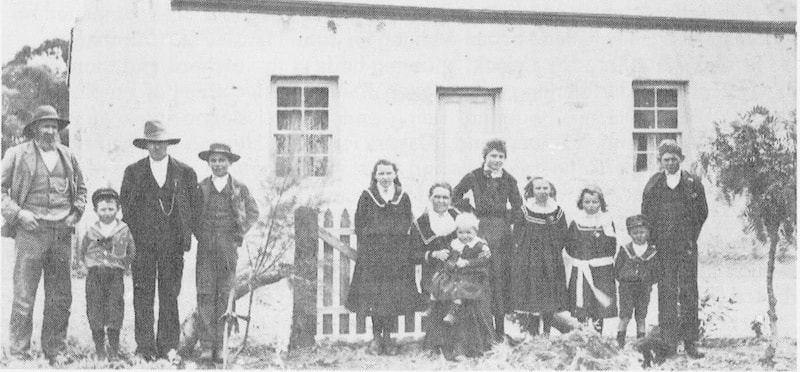
The Rivett family -Z. Rivett, Jack, Will, George, Sophia, Mary nursing Bob, May, Ethel, Myrtle, Oswald and Pere. 1902.
Our daughter Christine (now Mrs. Neil Watts) chose nursing as her career and loves her work at the Kingston Hospital. Her husband, Neil, is a builder and they have one son, Shawn, and we are lucky to have them live next door to us.
Both boys have married, Michael to a local girl, Jeanette Thomas, and they have a daughter, Kylie and a son, Dwaine. Terry married Tania Steinborner from Mt. Benson and they have a son Shane. We are very happy that they have both chosen to stay on the land and are the fourth generation of Rivetts to farm this area.
Shirley Rivett
Hocking Family
Henry Hocking was born at Burra in 1860. He moved with his family to Moonta when he was four and at the age of twenty he began working with the railways between Bordertown and Tailem Bend. In the late 1880’s he married Mary Gibbs, born 23.10.1865, from Mount Benson. He continued to work for the railways apart from a period when he was employed by the South East Drainage Board. During this time he assisted in the digging of Drain K. In the 1890’s the family moved into the railway cottages in Avenue Range.
Henry bought 24 acres of land in Downer township and in 1900 built a home there. This home is still standing. In 1907 he leased the water reserve, section number 332 from the Lucindale District Council and the family retained that lease until 1977.
Henry Hocking retired in 1927 and remained in the area until his death in the Nara coo rte Hospital in 1937. His wife Mary lived to the age of 95. She was well remembered for her assistance as midwife around the district.
The children born to Henry and Mary were: George Victor, Isaac, Albert, Sydney, Earnest, Elena and Jessie. Jessie, (Mrs. J. Jones), is still alive and living in Adelaide.
George Victor, the eldest son, attended school at Reedy Creek and the old Downer School, which was built in 1890, by W.S. Tavender. He completed his schooling at age twelve and began working for John Hensley at “Cairnbank”.
His day started at four o’clock, shooting birds in the orchard and then spent the rest of the day working as a station hand. Other areas of employment included wool picking, boundary riding and general station work at various properties including “Crower” and “Bakers Range”. He also grubbed trees for road making in the Tintinara district and assisted with harvesting in the Mallee.
From 1912 to 1921 he managed “Minniecrow” for Mr. W.A. Paltridge. He married Priscilla Pitt from Mount Benson in 1913.
Around 1912 he took up land adjoining Jacky White’s drain and purchased section 123, known as “Dead Horse Flat” in 1917. From around this date he rented ‘The Washpool” from W. Natt and purchased this land in 1930.
Section 71 at Bull Island was purchased in 1921. In 1922 he was granted a slaughter licence and operated a slaughter house and dairy there for many years. Meat was supplied to the local area, Lucindale, Kingston and Mount Benson. The dairy was sold in 1935.
Two well known draught stallions which George stood in the area were “Rob Roy” and “Northern Power”.
In 1934 the property “The Poplars”, at Conmurra was purchased from the estate of H. Langberg, for 6 pound/12/6 per acre.
George Victor died on 11.10.65, and his wife Priscilla died 1.2.59. Children from this marriage are: Victor Hartley born at Minniecrow 1914, Stanley Francis born at Avenue 1915 and Raymond Henry born at Naracoorte 1921. There was also a stillborn daughter.
All three sons attended school at-the Avenue Range School, before working on the land. They managed the properties as one until 1967 when it was divided into three, with Victor and Raymond and their families retaining the sections of land in the Conmurra district and Stanley and his family remaining in Avenue Range.
Stanley married Mary Hodge from Coonawarra in 1940. Their children are Marjorie Veeda and Rexton Kenneth who both attended the Avenue Range School. Rex ton attended until the school closed.
Majorie married and moved to the Mount Benson district.
Rexton married Kay Bird in 1965 and they live on “The Washpool” with their family. He spent ten years training trotting horses, including the world record holder “Reichman”, in Ballarat, Victoria, until 1980.
During the 1970’s sections 143 and 144 were purchased from T. Richman, and sections 83 and 84 were purchased from the Conrick family.
Kay Hocking is the present Lucindale District Councillor for Townsend Ward and was one of the first two women elected to the Lucindale Council. Their children are Janelle Elizabeth and Verity Mary.
Kay Hocking
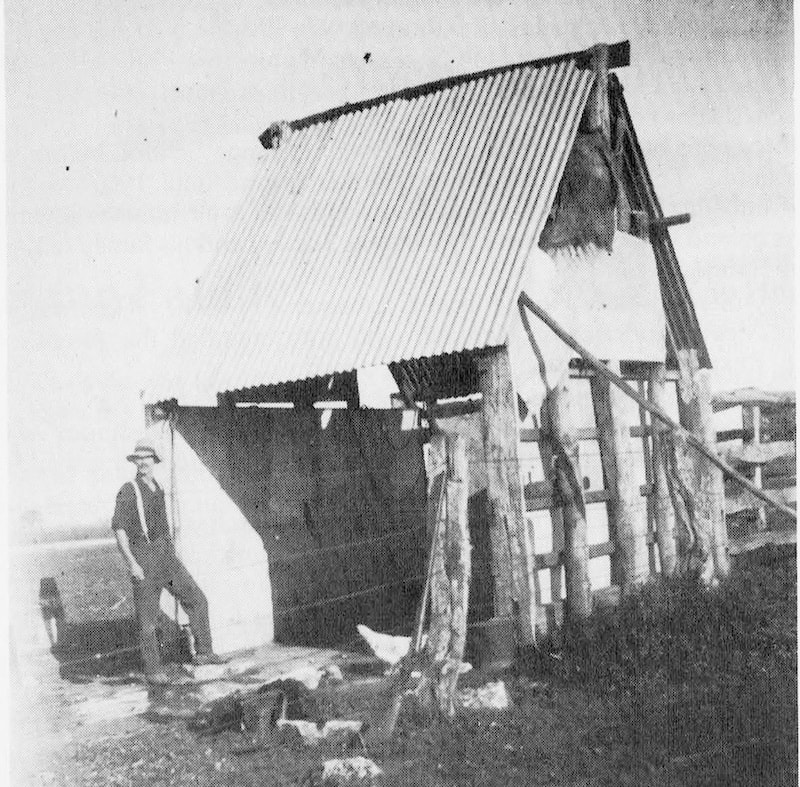
Bull Island Abbatoirs. Run by G. V. Hocking
Aitchison Grieve – “Fell wood”
Archibald Carmichael who was a grazier at “Fellwood”, Lucindale, was born in the year 1840 at Islay, Argyleshire, in the Highlands of Scotland. He came to South Australia in 1860 by the sailing vessel “Grand Trianan” and spent several years in the state and near Wellington on the River Murray learning about sheep raising. In 1880 he too? up 956 acres in the Lucindale district, which he cultivated for twelve months before launching himself into the sheep raising industry. Meeting with success in the later line he began making additions to his holding until he had about 9,000 acres of freehold and leasehold property.
In the early 1920’s my father, Aitchison Grieve, bought “Fellwood” from Archibald Carmichael. The name had already been given to the property, no doubt referring to the large amount of timber which had to be cleared before development could take place. At that time it included all the area of land (2,455 acres) known as ‘Stewarts’ which was bought by J.C. Smith and Sons in 1938 for 1,100 pounds, and renamed “The Valley”. At the close of World War II a further area was sold for Soldier Settlement. This area was divided into two blocks – “Talbots” (named after a stone cairn at the gateway which led into “The Valley” and known as Talbots Memorial) taken up by Jim McDowall, and “Avenue Plains” (named after the old homestead and woolshed which stood on the same site and once owned by the Morris family) taken up by George Hansberry.
Aitchison lived in the stone hut now used as a laundry for the first few years. When he married Constance Hansen in 1929 he rented the house now known as “Solo” at Crower. It was then owned by the Nosworthy family. He travelled by horse and gig to “Fellwood” each day – in the winter along the ridges not far from the present bitumen road. As there was no bridge the drain had to be forded at a fairly shallow place. However, in a wet winter the water would often be so deep that if flowed through the floor of the gig. In summer he crossed on the flats through the Crower “Lambing Paddock”.
In 1936 the present house was built using the dressed stone taken from the old homestead and woolshed on “Avenue Plains”. The removal of these ruins left the oldest woolpress in the South East standing alone and stark, reminding us of the former station and its owners. To supply lime for the building of his new home, my father used the natural limestone and scrub timber in the paddock now know as “Limekiln” to burn his own. After the stone was burnt it was bagged and carted to the site of the new house on a wagon with a team of four draught horses. Parts of the old Fellwood homestead were converted into shearers’ quarters which were used until the early 1970’s. In 1973 these were demolished to make way for the new quarters – a cement brick building with modern conveniences, carpeted floors and plenty of space.
In more recent years homes have been built for Judith and David Mugford, Joe Grieve and Jim and Sue Mugford.
In the early days one paddock was named “Strawberry” because the Department of Agriculture was conducting experiments on the suitability of Strawberry clover for the area. The clover was sown at the rate of a matchbox per acre for the 100 acre paddock. The Department also conducted trials with superphosphate using a “Shepherd” broadcaster to spread the super.
Judith Mugford
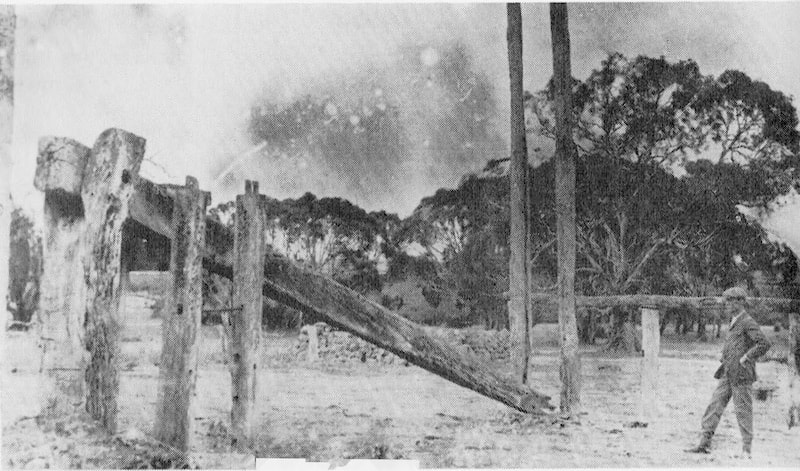
Old woopress at Avenue Plains Station 1916.
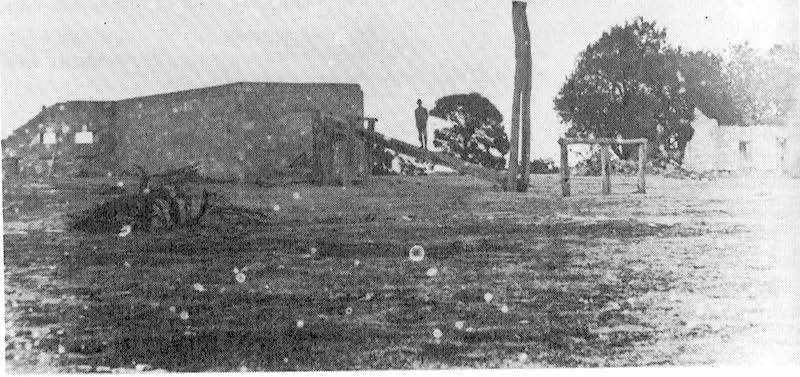
Shearing shed, Woolpress and Homestead at Avenue Plains Station 1916.
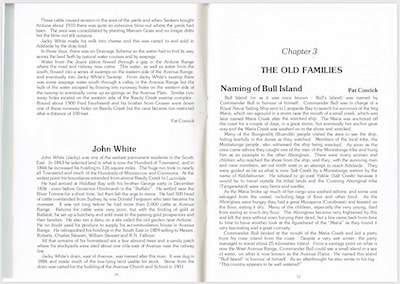
Download Original Chapter
